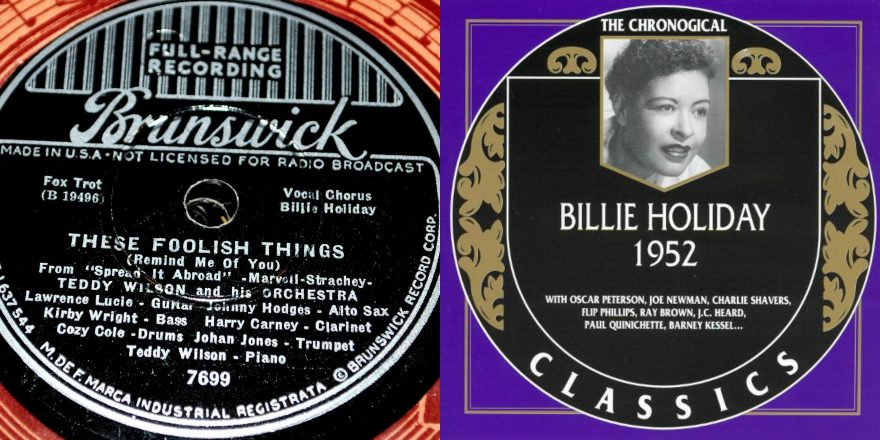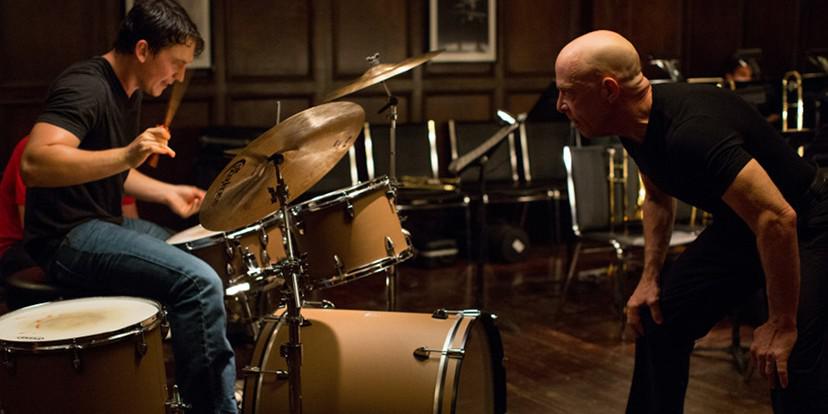Billie Holiday recorded two versions of “These Foolish Things (Remind Me of You)” — first in 1936 and again in 1952. Comparing the two is revealing: Holiday’s vocal style changes, as one would expect, but she also delivers two emotionally opposite, if equally wonderful, readings of the song.
I write songs and I sing songs. I made a career of composing in a style that referenced pre-war jazz. Apart from the pure pleasure of listening to these two versions, they prove to be a master class in musical arrangement and the realization of emotional intent. It’s not enough that Billie Holiday is revered, but it’s a good reason to listen closely. If you haven’t, this is a fine place to start.
“These Foolish Things” was written in a bit of a hurry by English lyricist Eric Maschwitz and musician Jack Strachey in 1934 for a BBC radio revue. He was lyrically inspired by Cole Porter’s “You’re the Top.”
“It was the first of what are now called catalog songs,” Maschwitz said in 1963. “I wanted to do the same thing for a romantic number.”
Six months later, Leslie “Hutch” Hutchinson made the song a hit. His version is completely of its time — that is to say, formally sweet, emotionally distant and dated.
In the early 1930s, Holiday was “discovered” singing in New York’s Harlem by white producer John Hammond. Hammond paired her with other artists he admired, most famously a young pianist named Teddy Wilson. The session that produced “These Foolish Things” took place in New York on June 30, 1936. Holiday was the default producer, because she picked the songs. As would usually happen, the pair rehearsed the day before in Wilson’s apartment. Thirty or forty songs were considered and whittled down to four.
“And we rehearsed them until she had a very good idea of them in her mind, in her ear,” Wilson recalled, “but there would be no rehearsal with the musicians; there was no need for rehearsals. They were all expert improvisers. Her ear wasn’t phenomenal, but she had to get a song into her ear so that she could do her own style on it.”
Billie Holiday may have chosen the songs, but it was still Teddy Wilson’s session. The Teddy Wilson Orchestra sides of the 1930s helped define the era as a heyday for small bands. On this day, the musicians included Johnny Hodges (alto sax) and Harry Carney (baritone sax) — both from Duke Ellington’s band — and Cozy Cole on drums. It was Billie Holiday’s eighth recording session. She had just turned twenty-one.
The band takes a walking tempo, Wilson and Carney trading solos over an entire form. Holiday doesn’t come in for a minute and a half. Her singing takes up less than half the side.
We are moving through space in this recording — an apartment, a city — as Holiday ticks off the things she associates with an absent love. The lyrics are clunky, which makes her bright, smiling delivery all the more endearing:
A tinkling piano in the next apartment
Those stumblin’ words that told you what my heart meant
A fair ground’s painted swings
These foolish things remind me of you
The feeling evoked is familiar: you may be alone, but your lover is omnipresent. Everything is reminiscent of shared experience, proof of togetherness. Although the lyrics may be ambiguous, it’s impossible to hear this version of “These Foolish Things” as a breakup song. When Holiday sings, “Oh how the ghost of you clings,” with a little Cab Calloway shudder, it’s as if she’s picked up a shirt that still smells like her man.
This version was the first I heard, after buying Teddy Wilson and His Orchestra Featuring Billie Holiday, an appetizing album title if ever there was. It was part of an apparently sunny collection of swing tunes, which on closer listening revealed many treasures — Wilson’s cascading arpeggios; Holiday’s voice, unaffected by age or better experience; the consistently excellent work of sidemen.
For someone who would become such a stylist, Holiday generally sticks to the tune on this version, even if she simplifies the melody. Her delivery resembles Louis Armstrong’s instrumental phrasing, something she often heard while running errands in a bordello as a child. This was no accident.
Holiday sings like a trumpet on ‘These Foolish Things.’
“I don’t think I’m singing,” she told Downbeat in 1939.“I feel like I am playing a horn. I try to improvise like Les Young, like Louis Armstrong, or someone else I admire. What comes out is what I feel. I hate straight singing. I have to change a tune to my own way of doing it. That’s all I know.”
Holiday sings like a trumpet on “These Foolish Things.” There are little lilting turnarounds and declarative high notes, perhaps a little out of her range. She slurs like a saxophone coming into the bridge because, at least to my ears, she blew the entrance. There are many times, listening to Billie Holiday, that one hears notes out of mode or simply made up. She sounds like she’s flying by the seat of her pants, letting her emotions guide her. This is partly why what she does is so clearly honest and affecting: she may have a limited musical vocabulary, but she excels at telling a story.
The Billie Holiday who sings “These Foolish Things” in 1936, partly from inexperience and technical limitations and a whole lot of heart, is communicating youthful enthusiasm. To underscore this, the song ends with a playful instrumental out riff after the optimistic trumpet solo. There’s nothing too heavy being communicated here. If there is loss, it’s temporary. The world is simply too full of potential to be discouraged.
The next Holiday interpretation of “These Foolish Things” took place almost exactly sixteen years later, in April 1952. There is another white impresario involved — this time Norman Granz, also known for founding Jazz at the Philharmonic and managing Ella Fitzgerald. Granz features one of his own “discoveries” on the session, the twenty-six-year-old Canadian pianist Oscar Peterson. The session took place on the other side of the country, in Los Angeles, and this version is in many ways the opposite of its predecessor.
Much had happened in the interim. Jazz was finally being considered a “proper” art form, much to the credit of people such as Hammond and Granz. More dramatically, Billie Holiday’s career had undergone a tectonic shift, largely taking place in 1939.
It was in that year that she wrote the lyrics for “God Bless the Child.”
Them that’s got shall have, them that’s not shall lose
So the Bible says, and it still is news
Mama may have, Papa may have
But God bless the child that’s got his own
It was also in 1939 that Holiday recorded “Strange Fruit,” a shocking, heartbreaking indictment of lynchings in the Jim Crow South. It became her best-selling record.
Southern trees bear a strange fruit
Blood on the leaves, and blood on the root
Black bodies swinging in the southern breeze
Strange fruit hanging from the poplar trees
This is not something, artistically, one can come back from. Billie Holiday was now more than a jazz singer; she was a voice for the desolate, an expression of loss. Her personal spiral into drug and alcohol abuse took its toll as well — she lost vocal range and suppleness. There were cracks now, and an emerging harshness. By now, Billie Holiday did resignation better than anybody.
Billie Holiday did resignation better than anybody.
This is the Holiday I came to know, and love, from such late-career songs as “I Thought About You,” off of Lady Sings the Blues. Because she’s so broke down, listening felt at first voyeuristic. It’s not, of course, even if it’s not easy going. Holiday had yet to reach the end of the line in 1952, but the hallmarks are there.
The ensuing half-decade would bring many attempts to “legitimize” Holiday’s career. She would be paired with string sections and complicated backing vocal arrangements. Ironically, Granz wanted to bring her back to a simple small band setting — purposefully reminiscent of her Teddy Wilson collaborations all those years ago.
The 1952 version of “These Foolish Things” also begins with piano, but instead of Wilson’s elegant recapitulation of the melody, Peterson offers a meditation on a single note. He plays what sounds like a melody from a broken music box, then descends into tempo and mode. Holiday, now on her sixty-seventh recording session, comes in floating above where the vocal should be. Again, it sounds almost like an accident: she starts on a higher note, and makes the subsequent notes work. Her voice drops down to the proper melody for the second verse, but this entrance is extraordinary. She exists on a different melodic plane. It’s an otherworldly effect.
By this time, Billie Holiday has almost become an imitation of herself. She has an identifiable stylistic bag of tricks, like the vibrato “waaah” at the end of words with no such vowel. The original melody is only referenced. It’s her song now, to do with as she pleases. The backing musicians cradle her like a wave.
We are sitting now, perhaps looking out an open window on a mild autumn evening, collecting souvenirs of loss.
She sings much the same list, but it is now communicated as a series of vignettes. The tempo has slowed dramatically, anchored by Ray Brown’s unerring upright bass. We are sitting now, perhaps looking out an open window on a mild autumn evening, collecting souvenirs of loss. There are no horns now, no riffs, only an almost excruciating space supporting Holiday’s vocal. “How strange, how sweet,” she sings, in a second bridge not included in the first recording, “to find you still.”
These things are dear to me
They seem to bring you near to me
The scent of smoldering leaves, the wail of steamers
Two lovers on the street who walk like dreamers
Oh, how the ghost of you clings!
These foolish things remind me of you
This is a real ghost now, as irretrievable as smoke, as transient as sound. There is no room for soloing in this performance, as there was on most of the 1936 version. Something important is being communicated, and when it has been, the song gently ends. There is no anger, only indirect sadness. Holiday is describing that which endures after an apparent ending. It must have taken a lot of living, and loss, to reach this level of emotional expression.
Billie Holiday died from heart failure seven years later, while under arrest for drug possession in her hospital bed. She was forty-four. Never a great technician, her greatest contribution was an insistence on emotional communication. She listened to jazz back when it was rock & roll — a subculture that prized energy and individuation — and carried that on through the genre’s insistence on technical ability. She was, at the end as at the beginning, resolutely her own self. This is how her friend Bea Colt described her:
Years ago we didn’t figure it was a militant attitude, but in retrospect I would say that Billie was militant. Maybe that’s what made her such an individualist — her style and her arrogance — because she was a marvelous entertainer. When she walked out you knew she was somebody, and she was going to be somebody.
There are precious few singers who have ever been able to wring two completely different, and equally convincing, readings from the same song in their career. Billie Holiday did it because she was somebody, not afraid to dig down deep. For me, growing up with big ears and precious little musical training, understanding this was a confirmation of my DIY background. You need no one’s permission, and few qualifications to get started beyond your own bravery.








